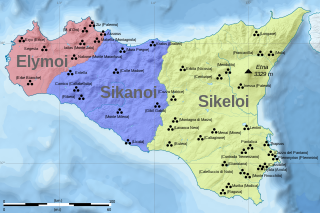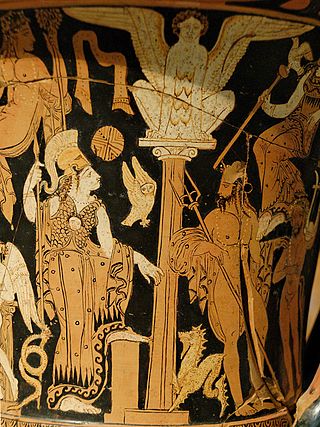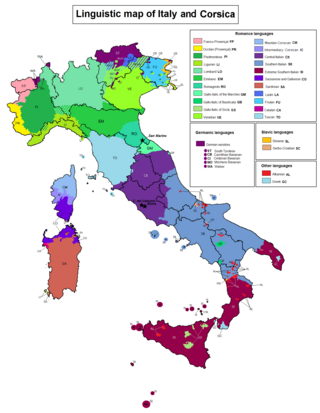
Sicily is the largest and most populous island in the Mediterranean Sea and one of the 20 regions of Italy. It is one of the five Italian autonomous regions and is officially referred to as Regione Siciliana. The island has 4.8 million inhabitants. Its capital city is Palermo. It is named after the Sicels, who inhabited the eastern part of the island during the Iron Age. Sicily has a rich and unique culture in arts, music, literature, cuisine, and architecture.

The Elymians were an ancient tribal people who inhabited the western part of Sicily during the Bronze Age and Classical antiquity.

The Lepontii were an ancient Celtic people occupying portions of Rhaetia in the Alps during the late Bronze Age/Iron Age. Recent archeological excavations and their association with the Golasecca culture and Canegrate culture point to a Celtic affiliation. From the analysis of their language and the place names of the old Lepontic areas, it was hypothesized that these people represent a layer similar to that Celtic but previous to the Gallic penetration in the Po valley. The suggestion has been made that the Lepontii may have been celticized Ligurians.

Sicilian is a Romance language that is spoken on the island of Sicily and its satellite islands. It belongs to the broader Extreme Southern Italian language group.

Messapic is an extinct Indo-European Paleo-Balkanic language of the southeastern Italian Peninsula, once spoken in Salento by the Iapygian peoples of the region: the Calabri and Salentini, the Peucetians and the Daunians. Messapic was the pre-Roman, non-Italic language of Apulia. It has been preserved in about 600 inscriptions written in an alphabet derived from a Western Greek model and dating from the mid-6th to at least the 2nd century BC, when it went extinct following the Roman conquest of the region.

The Sicels were an Indo-European tribe who inhabited eastern Sicily, their namesake, during the Iron Age. They spoke the Siculian language. After the defeat of the Sicels at the Battle of Nomae in 450 BCE and the death of Sicel leader Ducetius in 440 BCE, the Sicel state broke down and the Sicel culture merged into Magna Graecia.

The Faliscan language is the extinct Italic language of the ancient Falisci, who lived in Southern Etruria. Together with Latin, it formed the Latino-Faliscan languages group of the Italic languages. It seems probable that the language persisted, being gradually permeated with Latin, until at least 150 BC.

Elymian is the extinct language of the ancient Elymian people of western Sicily. Its characteristics are little known because of the extremely limited and fragmentary nature of the surviving texts.

The Sicilians, or Sicilian people, are a Romance-speaking ethnic group who are indigenous to the island of Sicily, the largest island in the Mediterranean Sea, as well as the largest and most populous of the autonomous regions of Italy.
The Sicani or Sicanians were one of three ancient peoples of Sicily present at the time of Phoenician and Greek colonization. The Sicani dwelt east of the Elymians and west of the Sicels, having, according to Diodorus Siculus, the boundary with the last in the ancient Himera river (Salso) after a series of battles between these tribes.

South Picene is an extinct Italic language belonging to the Sabellic subfamily. It is apparently unrelated to the North Picene language, which is not understood and therefore unclassified. South Picene texts were at first relatively inscrutable even though some words were clearly Indo-European. The discovery in 1983 that two of the apparently redundant punctuation marks were in reality simplified letters led to an incremental improvement in their understanding and a first translation in 1985. Difficulties remain. It may represent a third branch of Sabellic, along with Oscan and Umbrian, or the whole Sabellic linguistic area may be best regarded as a linguistic continuum. The paucity of evidence from most of the 'minor dialects' contributes to these difficulties.
Palike was an ancient city on Sicily. Its archeological site is located in Rocchicella on a spur of basalt in the valley of the Margi river. It lies at a distance of two kilometers to the west of the comune of Palagonia, but is part of the comune of Mineo, both in the province of Catania. The Sicilian Region has recently acquired the area and opened it to the public. An exhibition was created to show the materials found there during excavations.

North Picene, also known as North Picenian or Northern Picene, is a supposed ancient language, which may have been spoken in part of central-eastern Italy. The evidence for the language consists of four inscriptions dating from the 1st millennium BC, three of them no more than small broken fragments. It is written in a form of the Old Italic alphabet. While its texts are easily transliterated, none of them have been translated so far. It is not possible to determine whether it is related to any other known language. Despite the use by modern scholars of a similar name, it does not appear that North Picene is closely related to South Picene, and they may not be related at all. The total number of words in the inscriptions is about 60. It is not even certain that the inscriptions are all in one language.

Ducetius was a Hellenized leader of the Sicels and founder of a united Sicilian state and numerous cities. It is thought he may have been born around the town of Mineo. His story is told through the Greek historian Diodorus Siculus in the 1st century BCE, who drew on the work of Timaeus. He was a native Sicilian, but his education was Greek and was very much influenced by Greek civilization in Sicily. He is sometimes known by the Hellenized name of Douketios.

Gallo-Italic of Sicily, also known as the Siculo-Lombard dialects, is a group of Gallo-Italic languages found in about 15 isolated communities of central eastern Sicily. Forming a language island in the otherwise Sicilian language area, it dates back to migrations from northern Italy during the reign of Norman Roger I of Sicily and his successors.

The Aborigines in Roman mythology are the oldest inhabitants of central Italy, connected in legendary history with Aeneas, Latinus and Evander. They were supposed to have descended from their mountain home near Reate upon Latium, where they expelled the Sicels and subsequently settled down as Latini under a King Latinus.

Vassallaggi is a Sicilian prehistoric Bronze Age archaeological site, located on the hill of the same name, which had a later flourishing after the 7th century BC as a phrourion (fortress). The site is located in the middle of the Salso river valley, at 704 m above sea level, near San Cataldo in the province of Caltanissetta, in a strategic location for communication between the southern coast of Sicily and the northern part of the island. It has a NE-SW orientation and stretches along in parallel with the SS 122 San Cataldo-Serradifalco.
The Morgetes were an ancient Lucanian tribe, of Pelasgian descent, who occupied the region of southern Italy from Calabria to Sicily.
Herbessos was an ancient city located at Montagna di Marzo, Sicily, a few kilometres north-west of Piazza Armerina.











